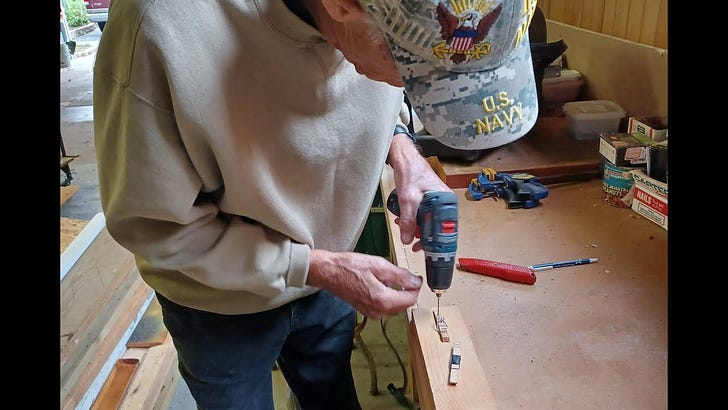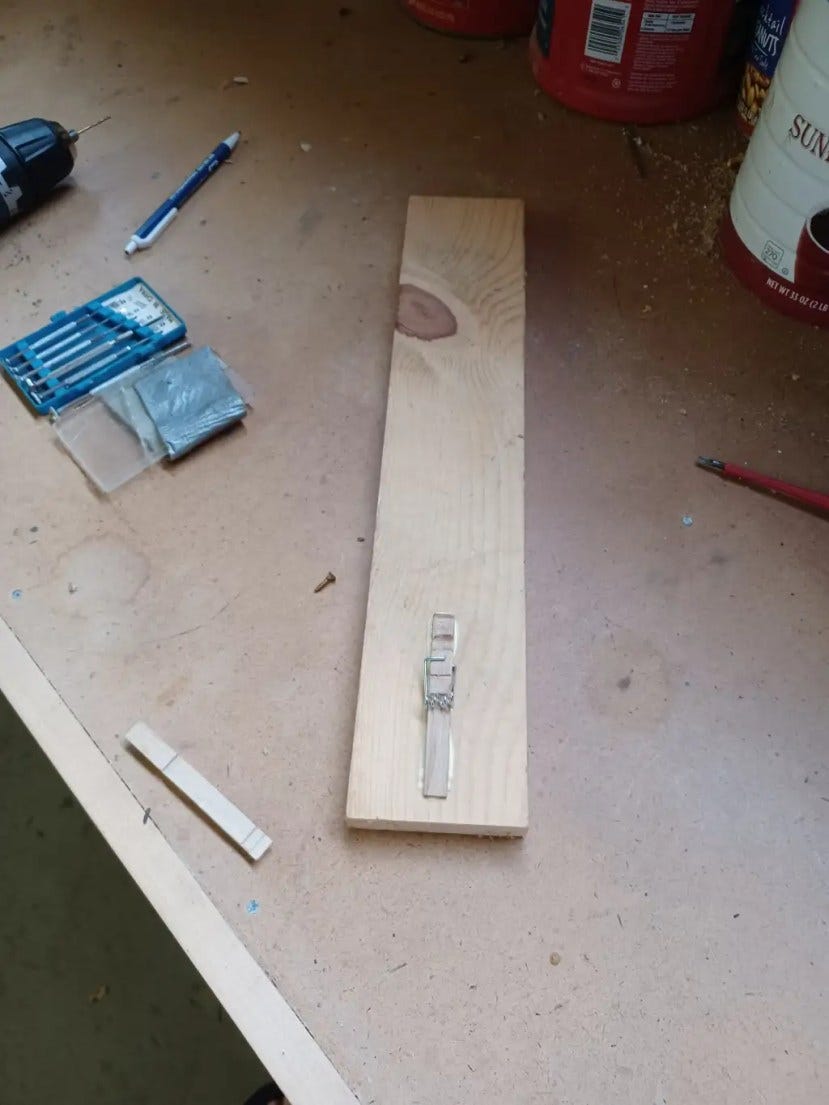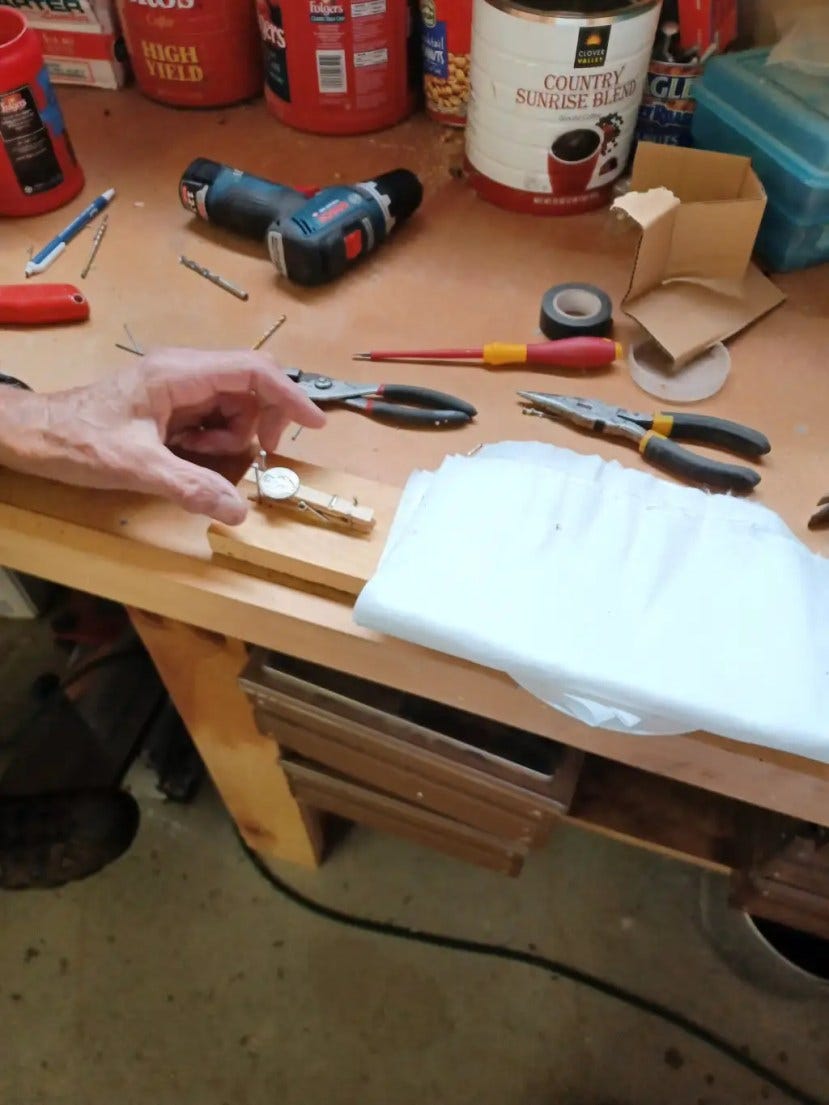By some idiot move on my part, I sent this too early before the video went live. It’s fixed, but those who got emails won’t know this. Apologies.
My dad and I built a coin flipping machine. Then made this video:
I am still new to this “video” thing, so I stupidly forgot to film the process of making the machine. I did, however, remember to take some pictures:
The idea, as the video explains, is to make a machine that flips a coin so that it always lands heads.
The base is scrap 2×4 we had lying around. Onto which is glued and screwed a spare clothespin with steel spring. The hope was the base would not move, and it doesn’t. Or at least not in any visible or important way.
The top part of the clothespin holds the quarter. It had a lot of lateral movement; basically the spring acted like a pivot point for sideways movement. To greatly reduce that, I pounded four nails into the board lined up with the clothespin as stops.
The forward stops fixed the amount of force the spring could give. To within limits. The wood of the pin had some give and flex, so that if you pushed too hard the amount of force could be increased.
The back stops were there to stop a great deal of the lateral movement of the pin. But as you’ll see in the video, it was not a good idea to put the quarter up against them, because that imparted a good deal of friction. Because of the cut grooves on the side of the quarter, this imparted friction was not predictable, and thus the coin would not always land heads.
Luckily, the clothespin had two lateral cuts made into it, which are designed to hold the spring. There are two because the sides of the wood could fit either side of the pin. So we lined up flips on one of the grooves.
The landing pad was tricky. A quarter hitting a hard surface, like a board, bounces, and in unpredictable ways. Something to soften the impact and allow the coin to lay flat was needed. Luckily, there was a styrofoam plate lying around, on which were once crackers loaded with pickled bologna (my dad’s favorite). Next time we’ll try pretzels.
Onto the plate I folded some shop rags. Took quite a few of them to make a landing zone soft enough to eliminate all bounce.
In the end the thing worked. There’s two sections showing it works in the video. The first test with my dad, at which it only worked so-so. Then another at the end after my explanation and after I made some tweaks. Worked great after that. You’ll see.
Still pretty ugly, though, but functional. A prototype only. A working—at least most of the time–prototype.
It works well enough to prove the contention that the probability of a coin flip showing a head is 1, or close to 1.
For this machine.
Because with this machine we have controlled most, but alas not yet all, of the causes of the result. Therefore the result is not random, which is to say it is predictable, because random means unpredictable. And this flip is predictable because we know the causes.
In a regular flip with your thumb there are the same forces, but they are uncontrolled, and delicate. There is friction on the thumbnail. The amount of upward force imparted to the coin is highly variable. The coin is not put in the same spot every time, which affects the amount of spin. The coin is caught at variable times and heights and on a surface (your hand) which changes from flip to flip.
The outcome is random, because it is unpredictable, and it is unpredictable because all the causes—those forces and material conditions—are not controlled.
Like I say in the video (and a million times elsewhere), nothing has a probability. All probability is conditional on the assumptions made. Here, the assumptions are fixed, or mostly so. On your thumb, they are not.
This doesn’t just work for coin flips, but for everything. Yes, even quantum mechanical objects, but we haven’t the time to go into that today.
Nothing has a probability. Probability doesn’t exist.
The video is choppy, ill-edited, and even confusing. Still getting the hang on it.
Subscribe or donate to support this site and its wholly independent host using credit card click here. Or use the paid subscription at Substack. Cash App: $WilliamMBriggs. For Zelle, use my email: matt@wmbriggs.com, and please include yours so I know who to thank.







"probability" is a concept of deception.
The "probability" of being struck by lightning is so small that no individual should ever be struck by lightning. Yet, individuals are struck every year. The same can be said of winning the lottery, yet individuals do win.
"probability" has nothing to do with individual specific cases! For specific people and cases, "probability" vanishes.
Wait, you have a dad? And did not spring forth full-grown and in full armor, from the head of Zeus? Not following this argument.